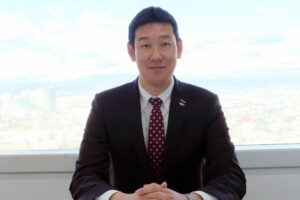By Aubrey Rose A. Inosante, Reporter
FUJIFILM Philippines is leveraging artificial intelligence (AI) and medical information technology (IT) to drive its healthcare expansion, with these technologies being central to the company’s strategy, according to its president Masahiro Uehara.
“This is our current initiative. We are offering an AI function. For the customers, they not only purchase our equipment but also, they add our AI function,” he said in an interview with BusinessWorld.
Fujifilm Philippines launched its AI-assisted portable X-ray device, FDR Xair, in September. This can perform tuberculosis screenings in three minutes with the help of a radiologist and doctor, reduce false positive samples, and save costs and time.
It also announced a new digital mammography system for breast cancer screening that offers “low dose, high image quality, and improved workflow” with AI technology.
“The Philippine General Hospital and Southern Philippine Medical Center, they use our medical IT system,” he said, adding that the purchased Fujifilm medical equipment of these institutions seamlessly pairs with their medical IT system.
In a broader view, Mr. Uehara also said the company’s medical expansion is driven by the popularity of diagnostic imaging firm Hitachi Ltd. in the country, which Fujifilm acquired in 2021.
“The Philippines is a very lucky market for Fujifilm. Hitachi’s presence was significant. That’s why the Philippine doctors and healthcare sector officers know that Fujifilm products are former Hitachi products,” Mr. Uehara said. “But other countries have another story.”
The Japanese firm’s healthcare business history dates back to 1936, when it started offering X-ray medical film.
At present, it has a diverse equipment lineup with ultrasound, endoscopy, computer telephony integration (CTI), magnetic resonance imaging (MRI), and more.
“Our long-term vision is to be the top brand in the Philippine market, especially in this kind of diagnostic imaging field. To fulfill this goal, we are currently investing a lot in the enhancement of customer satisfaction,” Mr. Uehara said.
Fujifilm Philippines has opened three service centers: Davao in February, Makati in September, and Cebu to oversee the Visayas area.
“Our product is indispensable for the people — healthcare and photography. So, that’s why automatically all employees understand so if we sell more, we can bring more happiness, more smiles to the people,” Mr. Uehara said when asked about Fujifilm’s longevity.
He attributed the economic growth of the Philippines and rising Filipino incomes to creating business and commercial opportunities for companies.
“Our main business is photography and healthcare. I’m especially optimistic about the healthcare demand. The Philippine government and private hospitals are investing more in enhancing medical services. We will have greater opportunities to provide our system technology,” Mr. Uehara said.
Since the pandemic, Fujifilm Philippines has maintained double-digit growth primarily driven by the healthcare business, he said.
TRANSFER FROM HK TO PHLAffectionately called “Masa” by his employees, Mr. Uehara was appointed as the new president of Fujifilm Philippines in November 2022 and was at the center of the firm’s new strategy after the pandemic.
Fujifilm had to downsize as sales started to falter amid the pandemic, he said.
But later revived due to the revenge buying trend and the acquisition of Hitachi, spawning new demand for the photography and medical businesses.
His transfer to the Philippines also came during the political turmoil in Hong Kong, where he was the Managing Director of Fujifilm Hong Kong Limited in 2018.
“The Hong Kong era was very tough also because of the pandemic. Before the pandemic, there was political turmoil — the conflict between the Hong Kong government and the Chinese government. I was there,” he said.
Mr. Uehara also added that the two countries differ in terms of business scale and dynamism as Hong Kong is smaller and customers can be reached within an hour, unlike in the Philippines, which is an archipelago.
Long before his appointment in these countries, he started as a product administrator in a factory in Japan near Mount Fuji in 2000, then later assigned to handle the Human Resources (HR) division from 2004 to 2012.
“This period was very hard. Because around 2000, our main business was, of course, photo-related business. Everyone was using analog cameras and had to print out photos. So, from this business, Fujifilm earned a lot of revenue and profit. But, of course, times have changed,” he said.
But as digital cameras arrived, Fujifilm’s sales profit dropped rapidly, and the company had to cut employment and shut down many factories to survive.
“All of those days, my role was HR. I had to explain why the company had to lay off employees. Very tough. Everyone was shouting. This is the company’s fault, not ours. I had to explain one by one,” he said.
When asked about his leadership style, Mr. Uehara said he keeps the balance of his responsibilities of fulfilling the sales profit target and keeping the employees happy.
“I have to make our employees happier and train them to have good careers. Luckily, now we are maintaining double-digit growth,” he said, adding that he always considers how to return the company’s growth to the employees.
